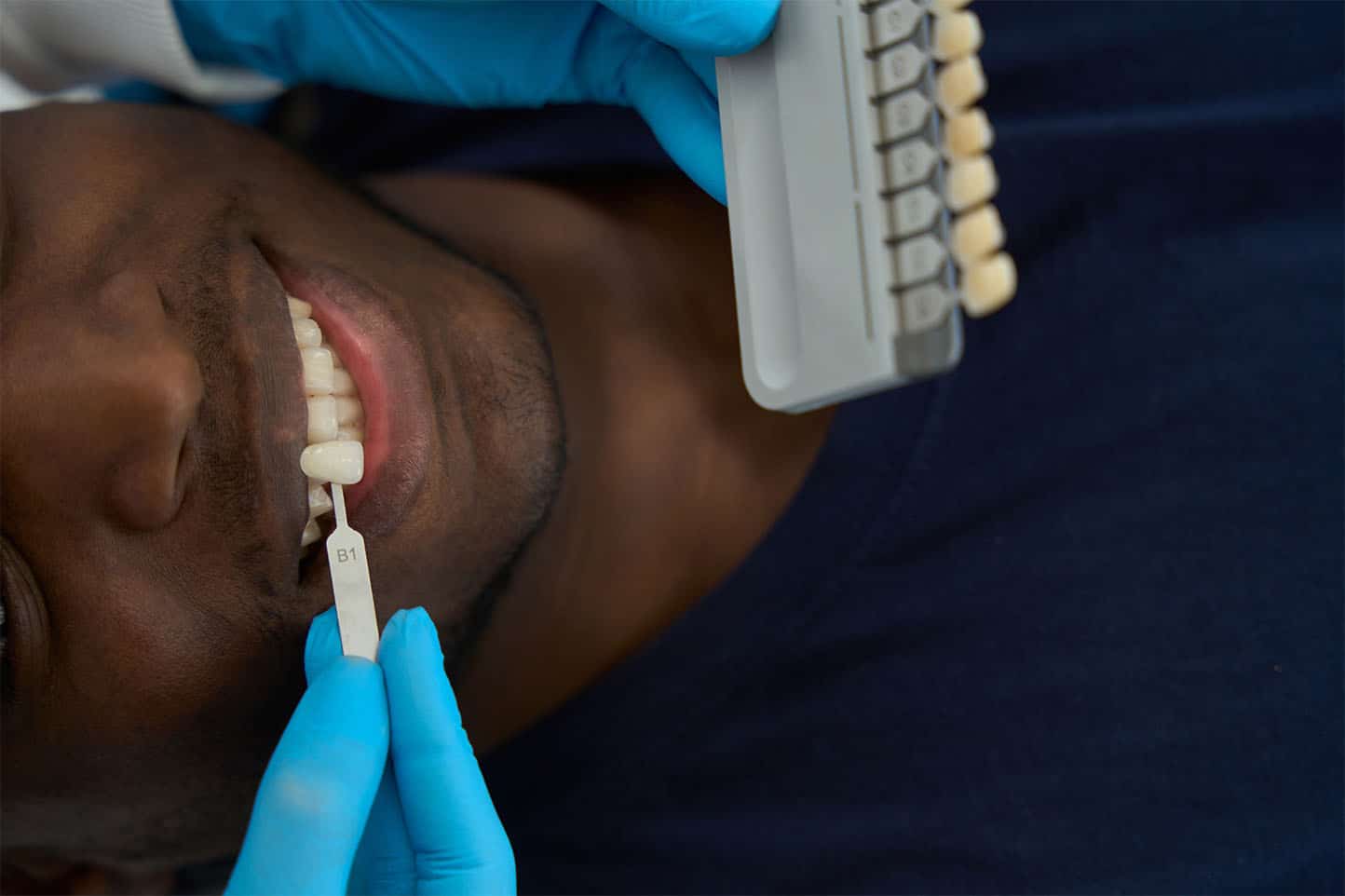Do you often hide your smile due to discolored, chipped, or irregularly shaped teeth? If so, you’re likely aware of the hit your self-confidence takes every time you refrain from sharing your smile with the world. But it doesn’t have to be this way. Dental veneers, a prevalent cosmetic procedure, can help improve your smile and provide a much-needed boost to your confidence.
This article will explore dental veneers, looking into what they are, their different types, the procedures involved, and the benefits they offer.
What Are Veneers Dental Treatments?
Veneers dental treatments involve the use of thin, custom-made layers of tooth-colored materials, notably porcelain or composite resin, that are affixed to the front surface of the teeth. This cosmetic dentistry procedure is primarily used as a solution to enhance the aesthetics of a smile and protect the tooth’s surface from future damage. These thin shells are tailored to fit each individual’s teeth perfectly, considering factors like shape, color, and size.
What Are the Different Types of Veneers?
- Porcelain Veneers. Traditional porcelain veneers are popular for their durability, resistance to stains, and the ability to match your natural tooth color closely.
- Composite Resin Veneers. Composite veneers are less costly and can be applied in a single dental visit. They are made from a tooth-colored composite resin, which is applied, shaped to the appropriate form and then hardened with a special light.
- Lumineers. Also known as no-prep veneers, they necessitate a lower amount of natural tooth structure removal than conventional veneers.
- Snap-On Veneers. They are removable veneers that snap on your actual teeth, providing an affordable, non-permanent alternative to traditional veneers. They are also known as pop-on veneers or clip-on veneers.
What Does a Dental Veneer Procedure Involve?
Step 1: Consultation and Treatment Planning
Having a brighter smile with dental veneers begins with a thorough consultation and treatment planning. In this initial appointment, a proficient dental team composed of cosmetic dentists will thoroughly assess your oral health with strict attention to oral hygiene and gum health.
This careful examination is crucial in establishing whether you’re a suitable candidate for veneers or not. During this phase, the dentist may also take intricate impressions of your teeth for further evaluation.
Step 2: Preparation for Veneer
Upon confirmation of your suitability for the veneer procedure, the dentist starts the preparation phase. In most cases, this stage involves the removal of a minute portion of tooth enamel from the tooth surface. This adjustment ensures that the veneer will beautifully fit and naturally align with the rest of your teeth.
Using a digital scanner, your dentist or a skilled dental technician gives an impression of the prepared tooth. This precise impression is subsequently sent to a dedicated laboratory where your veneer is expertly crafted.
Step 3: Fitting of Temporary Veneers
While your permanent veneer undergoes creation, your dentist will provide a temporary veneer to protect your tooth. This measure shields your sensitive tooth from any discomfort or potential damage during the week or two taken for your traditional porcelain veneers to be ready for final placement. With the aid of temporary veneers, you can still comfortably flaunt a smile as you await your permanent veneers.
Step 4: Bonding of Veneer
When the veneers are finally back from the specialized laboratory, your dentist initially places them on your teeth to verify the fit and color. To flawlessly bind the veneers onto your teeth, a special light, often an ultraviolet light, is used to harden the dental cement applied.
Any excess resin-based composite veneer material that may be present is carefully removed, after which the dentist polishes the marginal areas around the veneer. To ensure that your bite remains unaffected, a meticulous check on your bite position is conducted to ensure it remains comfortable and natural.
Step 5: Follow-Up Visit
To keep a close eye on your gums and newly placed veneer, a follow-up appointment is scheduled a couple of weeks post-procedure. During this crucial visit, your dentist assesses the reaction of your gums to your new veneers. Depending on the individual, most gums respond positively to the introduction of veneers, leading to a seamless fit.
What Are the Benefits of Getting Dental Veneers?
Improved Appearance
One of the standout advantages of dental veneers is the immediate transformation they offer for individuals with stained or discolored teeth. The color versatility of veneers is unrivaled, allowing for adjustments until they match the exact color of your natural teeth. This unique feature ensures that your veneer-fitted teeth do not awkwardly stand out among your real teeth but instead blend in seamlessly for a natural look.
Fix Minor Cosmetic Problems
Veneers take pride in their reputation for efficiently masking minor cosmetic problems. Chipped teeth, malformed single teeth, and noticeable gaps between teeth all fall under this category. Such imperfections, especially those that are egregiously visible when you talk or smile, can be effectively masked with well-placed veneers.
Long-Lasting Solution
By opting for porcelain veneers, you stand to benefit from their renowned strength and resilience that match the natural tooth enamel. The characteristic resistance to staining of porcelain veneers is something to behold, even though composite veneers may call for more vigorous efforts from the care team to remain stain-free.
Boosted Confidence
A bright, perfect smile can be a huge confidence booster, setting the stage for profound improvements in your social, personal, and professional interactions. Making such a significant smile a reality is well within the scope of dental veneers, leaving you with no other option than unapologetically flashing your brilliant smile.
Requires Minimal Tooth Enamel Removal
In contrast to other procedures like crowns or caps, veneers, particularly composite veneers such as resin-based composite veneers and acrylic veneers, require only a minimal amount of tooth enamel removal. The treatment involves bonding the veneer to the front of your teeth, which is considered a less invasive procedure compared to other options. This technique ensures that your natural tooth structure is preserved to the highest degree.
When to Consider Dental Veneers?
- Stained Teeth. If your teeth are discolored due to tooth decay or consumption of food and drinks that stain teeth, dental veneers can provide a whiter smile.
- Bruxism (Teeth Grinding). If your teeth are worn down from grinding, veneers can help restore them to their ideal size and shape.
- Chipped or Broken Teeth. Veneers can cover and protect the damaged tooth while providing a natural appearance.
- Malocclusion (Misaligned, Uneven, or Irregularly Shaped Teeth). Dental veneers can help reshape your smile, giving you the perfect teeth you’ve always wanted.
- Gap Teeth. If you have gaps between your teeth, veneers can help close the gaps and give your teeth a uniform and aligned look.
Achieve a Stunning Smile With Dental Veneers at Casey Dental
A dazzling smile is now within your hand. If you’ve spent countless hours hiding your smile and shying away from photos, it’s time for a change. Dental veneers at Casey Dental can offer you a fresh start and a radiant smile you can be proud of. Our team of experienced cosmetic dentists will guide you through each step, ensuring your comfort and satisfaction.
Don’t put off the smile of your dreams any longer. Call Casey Dental today at (570) 231-3829, and let us transform your smile with dental veneers.






